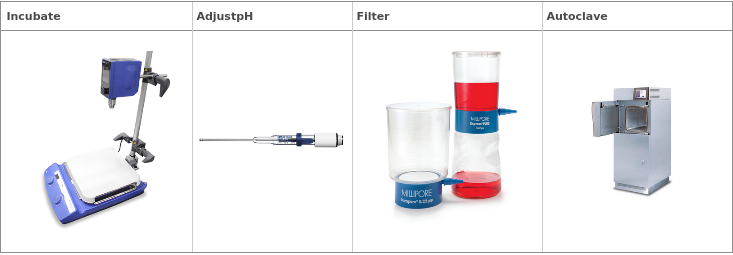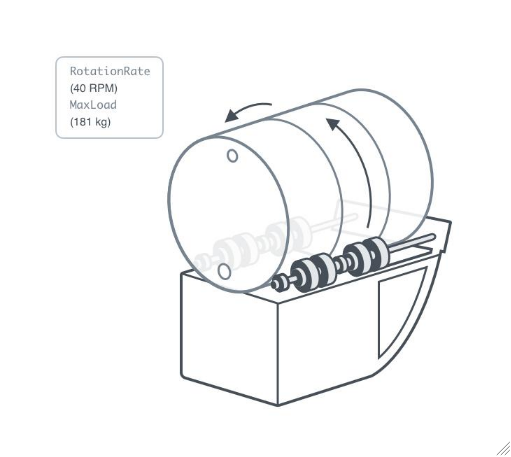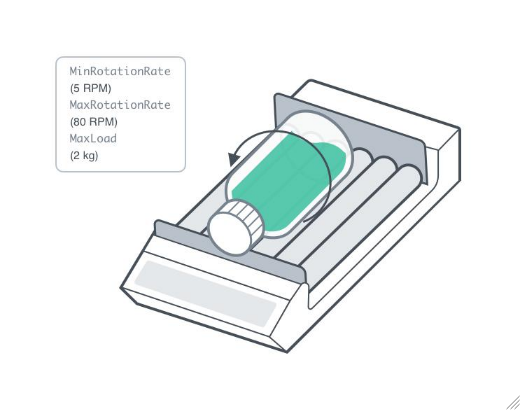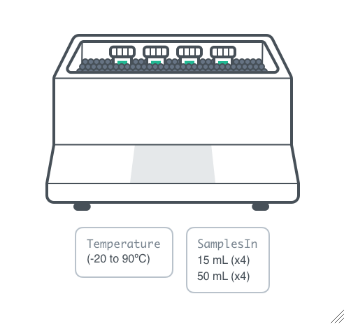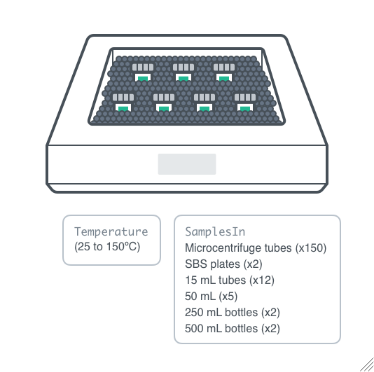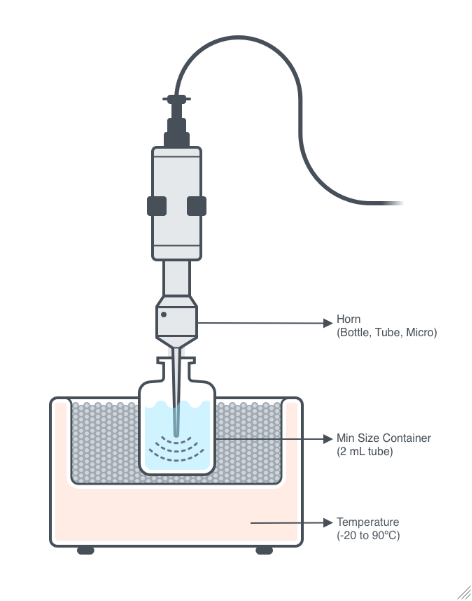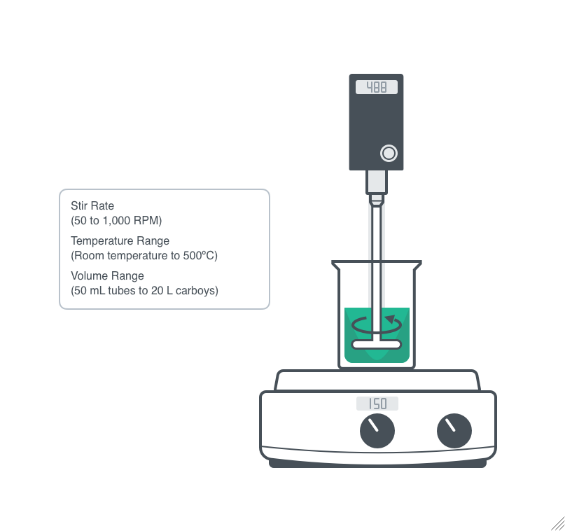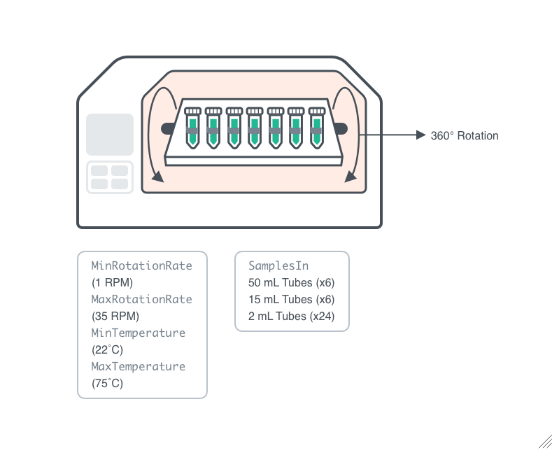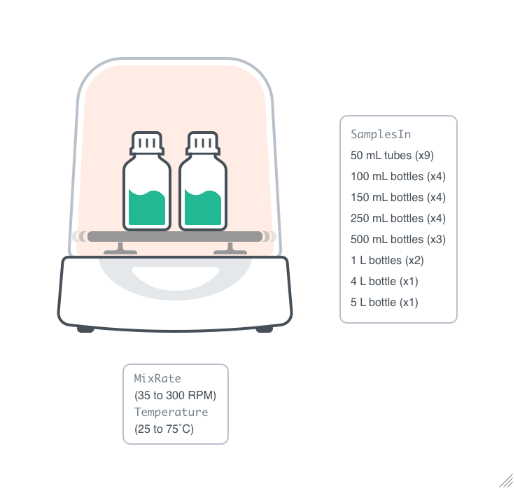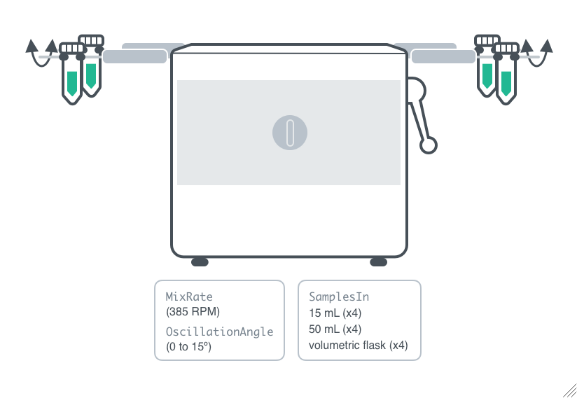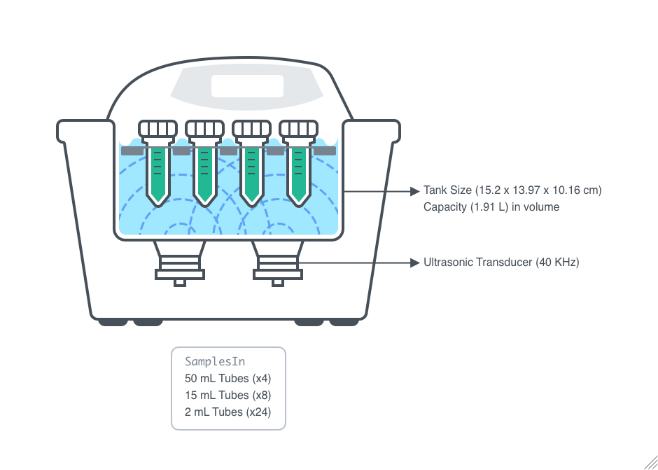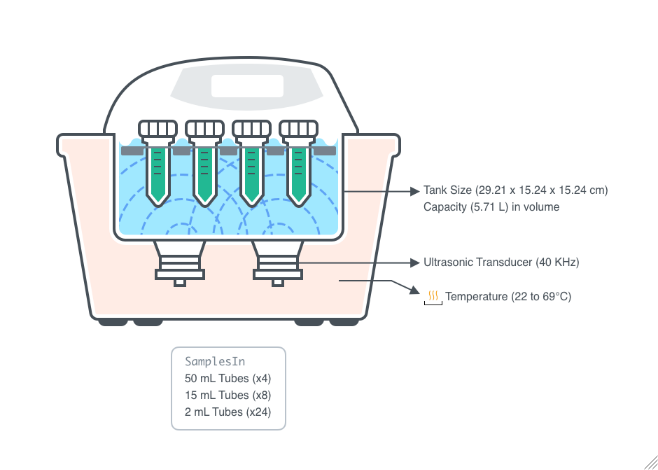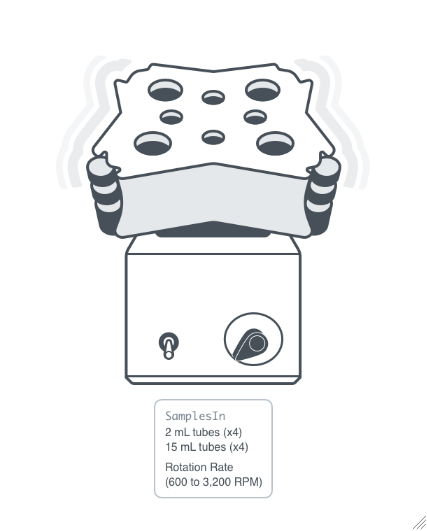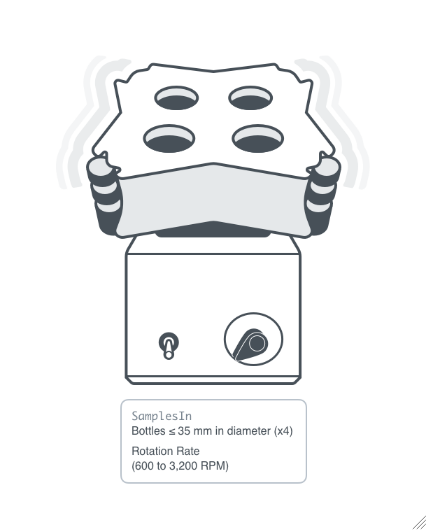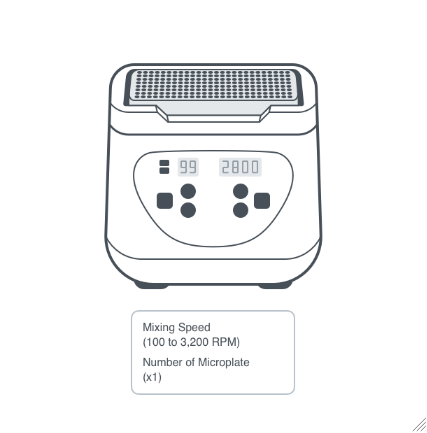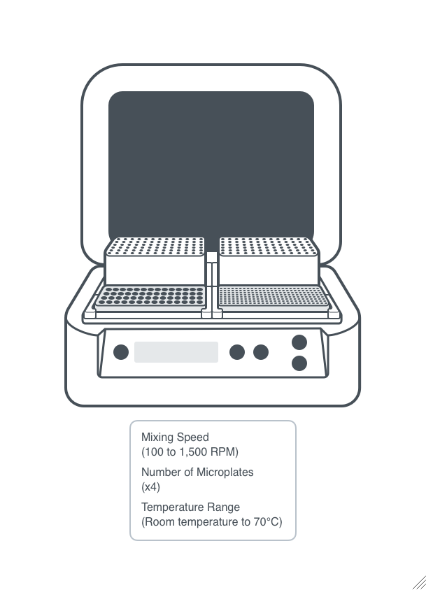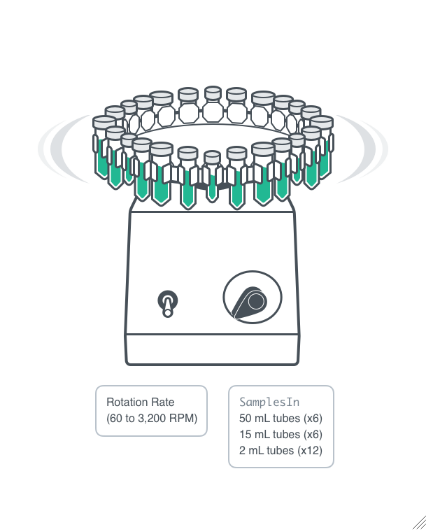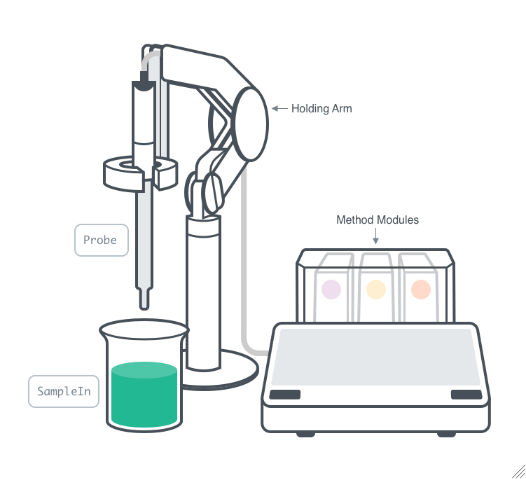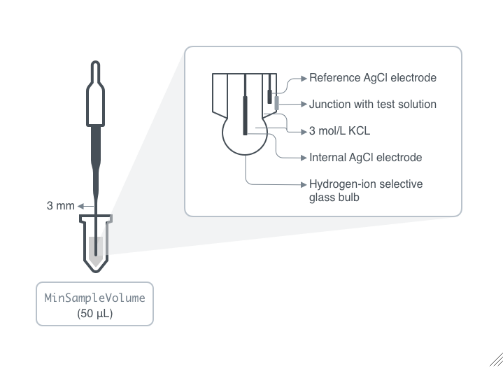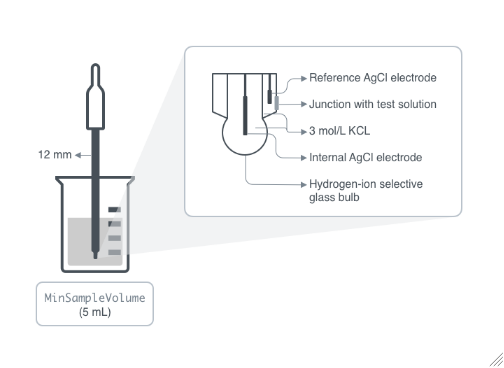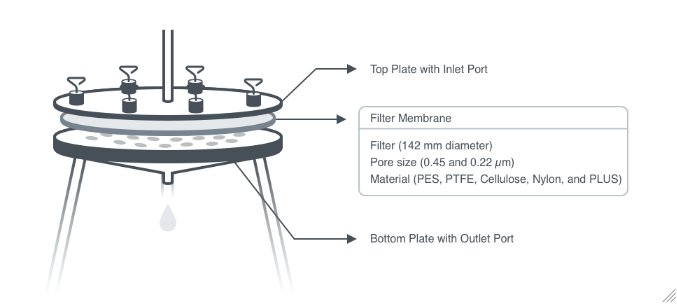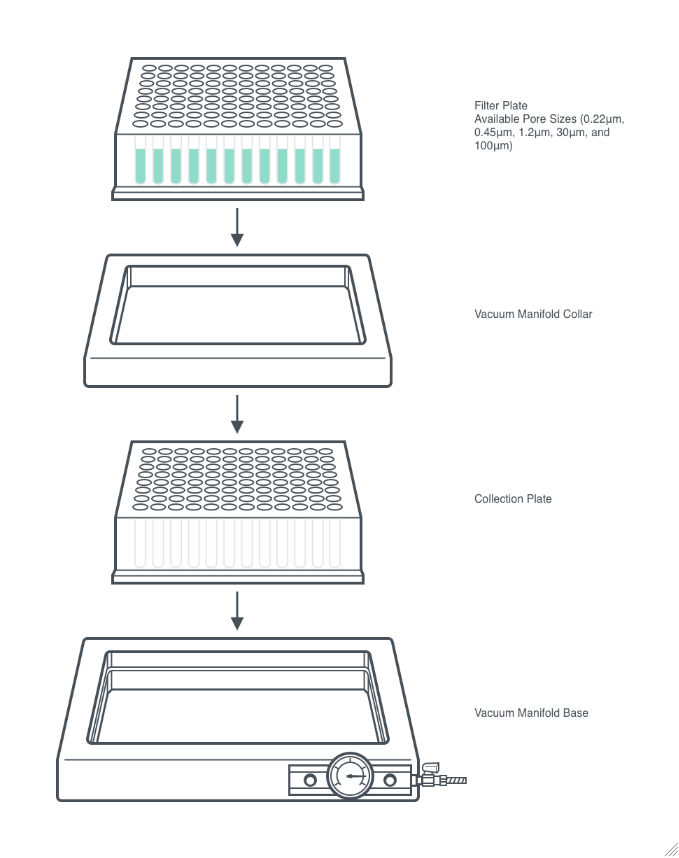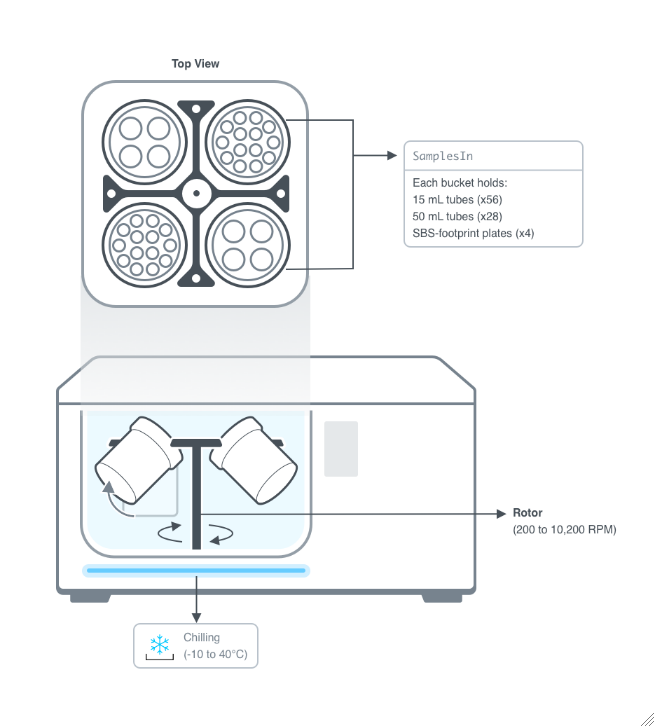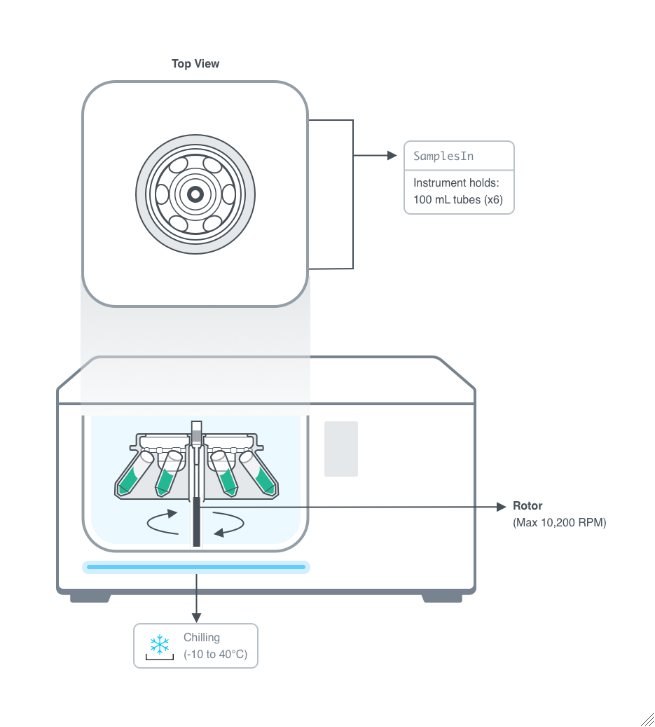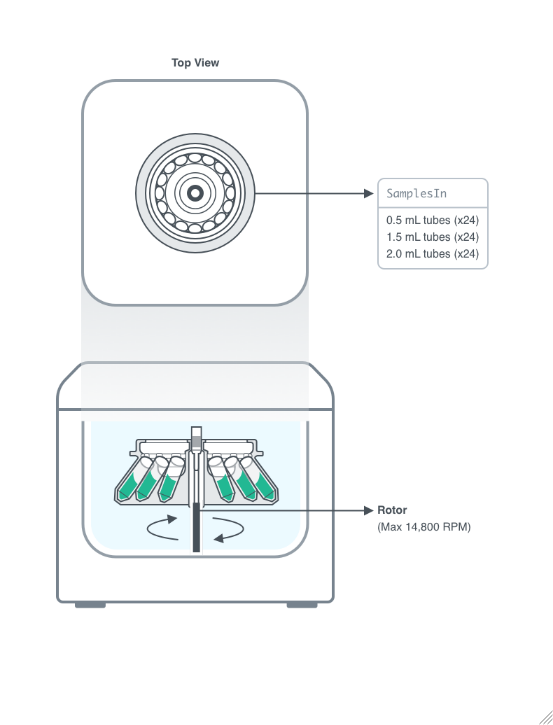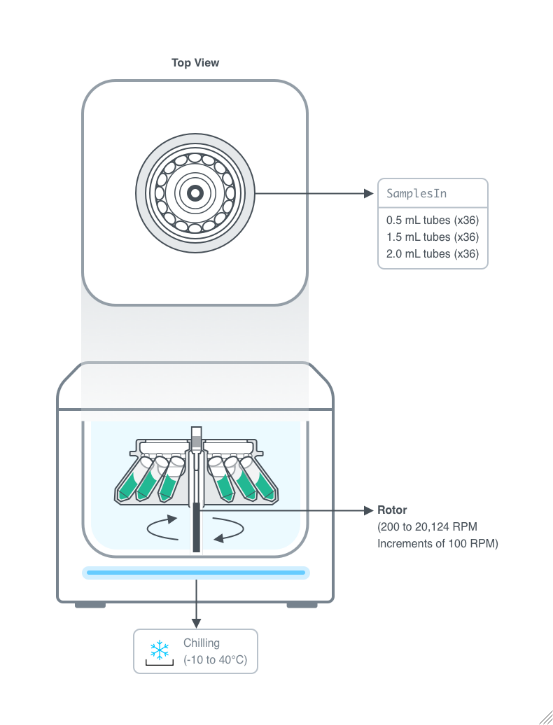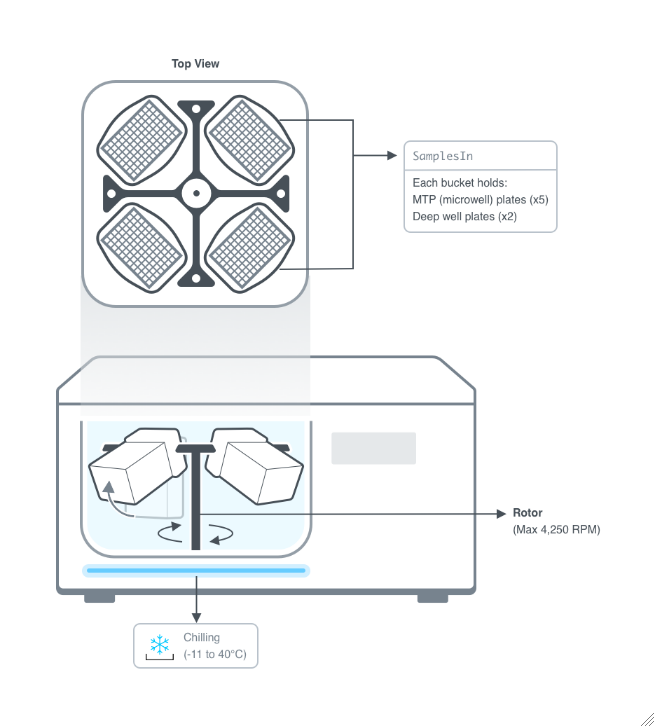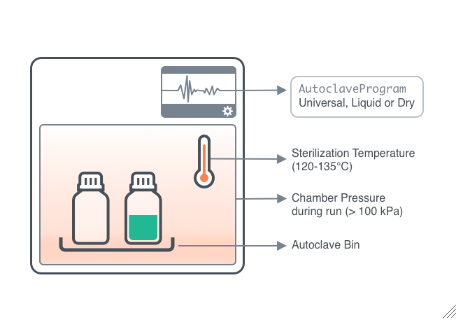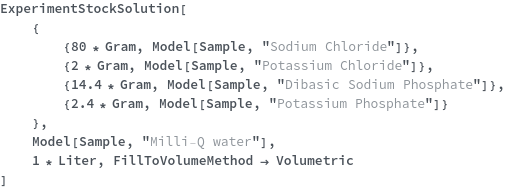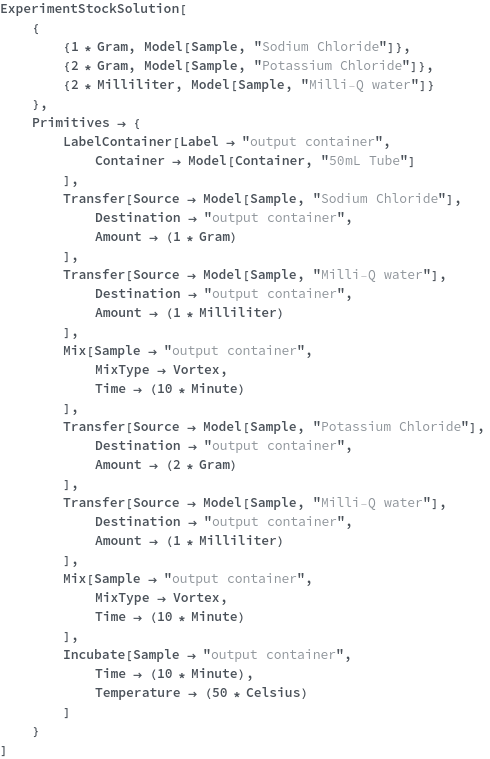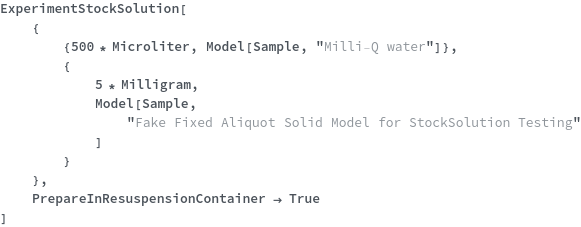Preparation
OrderOfOperations
The order in which solution preparation steps will be carried out to create the stock solution. By default, the order is {FixedReagentAddition, FillToVolume, pHTitration, Incubation, Filtration}. FixedReagentAddition must always be first, Incubation/Mixing must always occur after FillToVolume/pHTitration and Filtration must always occur last. The FillToVolume/pHTitration stages are allowed to be swapped.
Default Calculation: By default, the order is {FixedReagentAddition, FillToVolume, pHTitration, Incubation, Filtration}. FixedReagentAddition must always be first, Incubation/Mixing must always occur after FillToVolume/pHTitration and Filtration must always occur last. The FillToVolume/pHTitration stages are allowed to be swapped. When using a UnitOperations input, resolves to Null.
Pattern Description: List of one or more FixedReagentAddition, FillToVolume, pHTitration, Incubation, or Filtration entries or Null.
Programmatic Pattern: ({(FixedReagentAddition | FillToVolume | pHTitration | Incubation | Filtration)..} | Automatic) | Null
Index Matches to: experiment samples
Volume
The volume of the stock solution model that should be prepared. Formula component amounts will be scaled according to the TotalVolume specified in the stock solution model if this Volume differs from the model's TotalVolume. This option is not be used with the direct formula definition.
Default Calculation: Automatically resolves to the TotalVolume field of the stock solution, or to the sum of the volumes of any liquid formula components if the TotalVolume is unknown for a first-time preparation of a stock solution.
Pattern Description: Greater than or equal to 0.1 microliters and less than or equal to 20 liters.
Programmatic Pattern: RangeP[$MinStockSolutionComponentVolume, $MaxStockSolutionComponentVolume] | Automatic
Index Matches to: experiment samples
FillToVolumeMethod
The method by which to add the Solvent specified in the stock solution model to the bring the stock solution up to the TotalVolume specified in the stock solution model.
Default Calculation: Resolves to Null if there is no Solvent/TotalVolume. Otherwise, will resolved based on the FillToVolumeMethod in the given Model[Sample, StockSolution].
Pattern Description: Ultrasonic or Volumetric or Null.
Programmatic Pattern: (FillToVolumeMethodP | Automatic) | Null
Index Matches to: experiment samples
PrepareInResuspensionContainer
Indicate if the stock solution should be prepared in the original container of the FixedAmount component in its formula. PrepareInResuspensionContainer cannot be True if there is no FixedAmount component in the formula, and it is not possible if the specified amount does not match the component's FixedAmount.
Default Calculation: Automatically resolves to False unless otherwise specified.
Pattern Description: True or False or Null.
Programmatic Pattern: (BooleanP | Automatic) | Null
Index Matches to: experiment samples
Incubation
Incubate
Indicates if the stock solution should be treated at a specified temperature following component combination and filling to volume with solvent. May be used in conjunction with mixing.
Default Calculation: Automatically resolves to True if any other incubate options are specified, or, if a template model is provided, resolves based on whether that template has incubation parameters.
Pattern Description: True or False.
Programmatic Pattern: BooleanP | Automatic
Index Matches to: experiment samples
Incubator
The instrument that should be used to treat the stock solution at a specified temperature following component combination and filling to volume with solvent.
Default Calculation: Automatically resolves to an appropriate instrument based on container model, or Null if Incubate is set to False.
Pattern Description: An object of type or subtype Model[Instrument, Roller], Model[Instrument, OverheadStirrer], Model[Instrument, Vortex], Model[Instrument, Shaker], Model[Instrument, BottleRoller], Model[Instrument, Roller], Model[Instrument, Sonicator], Model[Instrument, HeatBlock], Model[Instrument, Homogenizer], Model[Instrument, Disruptor], Model[Instrument, Nutator], Model[Instrument, Thermocycler], Model[Instrument, EnvironmentalChamber], Model[Instrument, Pipette], Object[Instrument, Roller], Object[Instrument, OverheadStirrer], Object[Instrument, Vortex], Object[Instrument, Shaker], Object[Instrument, BottleRoller], Object[Instrument, Roller], Object[Instrument, Sonicator], Object[Instrument, HeatBlock], Object[Instrument, Homogenizer], Object[Instrument, Disruptor], Object[Instrument, Nutator], Object[Instrument, Thermocycler], Object[Instrument, EnvironmentalChamber], or Object[Instrument, Pipette] or Null.
Programmatic Pattern: (ObjectP[Join[MixInstrumentModels, MixInstrumentObjects]] | Automatic) | Null
Index Matches to: experiment samples
IncubationTemperature
Temperature at which the stock solution should be treated for the duration of the IncubationTime following component combination and filling to volume with solvent.
Default Calculation: Automatically resolves to the maximum temperature allowed for the incubator and container. Resolves to 37 Celsius if the sample is being incubated, or Null if Incubate is set to False.
Pattern Description: Greater than or equal to 22 degrees Celsius and less than or equal to 500 degrees Celsius or Null.
Programmatic Pattern: (RangeP[22*Celsius, $MaxIncubationTemperature] | Automatic) | Null
Index Matches to: experiment samples
IncubationTime
Duration for which the stock solution should be treated at the IncubationTemperature following component combination and filling to volume with solvent. Note that if you are mixing AND incubating and this option is specified, it must be the same as the specified value of the MixTime option.
Default Calculation: Automatically resolves to 0.5 Hour if Incubate is set to True and Mix is set to False, or Null otherwise.
Pattern Description: Greater than or equal to 1 minute and less than or equal to 72 hours or Null.
Programmatic Pattern: (RangeP[1*Minute, $MaxExperimentTime] | Automatic) | Null
Index Matches to: experiment samples
AnnealingTime
Minimum duration for which the stock solution should remain in the incubator allowing the solution and incubator to return to room temperature after the MixTime has passed if mixing while incubating.
Default Calculation: Automatically resolves to 0 Minute, or Null if Incubate is set to False.
Pattern Description: Greater than or equal to 0 minutes and less than or equal to 72 hours or Null.
Programmatic Pattern: (RangeP[0*Minute, $MaxExperimentTime] | Automatic) | Null
Index Matches to: experiment samples
Mixing
Mix
Indicates if the components of the stock solution should be mechanically incorporated following component combination and filling to volume with solvent.
Default Calculation: Automatically resolves to True if a new stock solution formula is provided, to True if an existing stock solution model with mixing parameters is provided, and to False if the provided stock solution model has no mixing parameters.
Pattern Description: True or False.
Programmatic Pattern: BooleanP | Automatic
Index Matches to: experiment samples
MixType
The style of motion used to mechanically incorporate the components of the stock solution following component combination and filling to volume with solvent.
Default Calculation: Automatically resolves based on the Volume option and size of the container in which the stock solution is prepared.
Pattern Description: Roll, Vortex, Sonicate, Pipette, Invert, Stir, Shake, Homogenize, Swirl, Disrupt, or Nutate or Null.
Programmatic Pattern: (MixTypeP | Automatic) | Null
Index Matches to: experiment samples
MixUntilDissolved
Indicates if the complete dissolution of any solid components should be verified following component combination, filling to volume with solvent, and any specified mixing steps.
Pattern Description: True or False or Null.
Programmatic Pattern: (BooleanP | Automatic) | Null
Index Matches to: experiment samples
Mixer
The instrument that should be used to mechanically incorporate the components of the stock solution following component combination and filling to volume with solvent.
Default Calculation: Automatically resolves based on the MixType and the size of the container in which the stock solution is prepared.
Pattern Description: An object of type or subtype Model[Instrument, Roller], Model[Instrument, OverheadStirrer], Model[Instrument, Vortex], Model[Instrument, Shaker], Model[Instrument, BottleRoller], Model[Instrument, Roller], Model[Instrument, Sonicator], Model[Instrument, HeatBlock], Model[Instrument, Homogenizer], Model[Instrument, Disruptor], Model[Instrument, Nutator], Model[Instrument, Thermocycler], Model[Instrument, EnvironmentalChamber], Model[Instrument, Pipette], Object[Instrument, Roller], Object[Instrument, OverheadStirrer], Object[Instrument, Vortex], Object[Instrument, Shaker], Object[Instrument, BottleRoller], Object[Instrument, Roller], Object[Instrument, Sonicator], Object[Instrument, HeatBlock], Object[Instrument, Homogenizer], Object[Instrument, Disruptor], Object[Instrument, Nutator], Object[Instrument, Thermocycler], Object[Instrument, EnvironmentalChamber], or Object[Instrument, Pipette] or Null.
Programmatic Pattern: (ObjectP[Join[MixInstrumentModels, MixInstrumentObjects]] | Automatic) | Null
Index Matches to: experiment samples
MixTime
The duration for which the stock solution should be mixed following component combination and filling to volume with solvent.
Default Calculation: Automatically resolves from the MixTime field of the stock solution model. If the model has no preferred time, resolves to 3 minutes. If MixType is Pipette or Invert, resolves to Null. 0 minutes indicates no mixing. Note that if you are mixing AND incubating and this option is specified, it must be the same as the specified value of the IncubationTime option.
Pattern Description: Greater than or equal to 0 hours and less than or equal to 72 hours or Null.
Programmatic Pattern: (RangeP[0*Hour, $MaxExperimentTime] | Automatic) | Null
Index Matches to: experiment samples
MaxMixTime
The maximum duration for which the stock solutions should be mixed in an attempt to dissolve any solid components following component combination and filling to volume with solvent.
Default Calculation: Automatically resolves based on the MixType if MixUntilDissolved is set to True. If MixUntilDissolved is False, resolves to Null.
Pattern Description: Greater than or equal to 1 second and less than or equal to 72 hours or Null.
Programmatic Pattern: (RangeP[1*Second, $MaxExperimentTime] | Automatic) | Null
Index Matches to: experiment samples
MixRate
The frequency of rotation the mixing instrument should use to mechanically incorporate the components of the stock solutions following component combination and filling to volume with solvent.
Default Calculation: Automatically resolves based on the MixType and the size of the container in which the solution is prepared.
Pattern Description: Greater than or equal to 0.2 revolutions per minute and less than or equal to 3200 revolutions per minute or Null.
Programmatic Pattern: (RangeP[$MinMixRate, $MaxMixRate] | Automatic) | Null
Index Matches to: experiment samples
NumberOfMixes
The number of times the stock solution should be mixed by inversion or repeatedly aspirated and dispensed using a pipette following component combination and filling to volume with solvent.
Default Calculation: Automatically resolves to 10 when MixType is Pipette, 3 when MixType is Invert, or Null otherwise.
Pattern Description: Greater than or equal to 1 and less than or equal to 50 in increments of 1 or Null.
Programmatic Pattern: (RangeP[1, 50, 1] | Automatic) | Null
Index Matches to: experiment samples
MaxNumberOfMixes
The maximum number of times the stock solutions should be mixed in an attempt to dissolve any solid components following component combination and filling to volume with solvent.
Default Calculation: Automatically resolves based on the MixType if MixUntilDissolved is set to True, and to Null otherwise.
Pattern Description: Greater than or equal to 1 and less than or equal to 50 in increments of 1 or Null.
Programmatic Pattern: (RangeP[1, 50, 1] | Automatic) | Null
Index Matches to: experiment samples
MixPipettingVolume
The volume of the stock solution that should be aspirated and dispensed with a pipette to mix the solution following component combination and filling to volume with solvent.
Default Calculation: Automatically resolves to 50% of the total stock solution volume if MixType is Pipette, and Null otherwise.
Pattern Description: Greater than or equal to 1 microliter and less than or equal to 5 milliliters or Null.
Programmatic Pattern: (RangeP[1*Microliter, 5*Milliliter] | Automatic) | Null
Index Matches to: experiment samples
pH Titration
AdjustpH
Indicates if the pH (measure of acidity or basicity) of this stock solution should be adjusted after component combination, filling to volume with solvent, and/or mixing.
Default Calculation: Automatically set to True if any other pHing options are specified, or if NominalpH is specified in the template model, or False otherwise.
Pattern Description: True or False.
Programmatic Pattern: BooleanP | Automatic
Index Matches to: experiment samples
pH
The pH to which this stock solution should be adjusted following component combination, filling to volume with solvent, and/or mixing.
Default Calculation: Automatically resolves from the NominalpH field in the stock solution.
Pattern Description: Greater than or equal to 0 and less than or equal to 14 or Null.
Programmatic Pattern: (RangeP[0, 14] | Automatic) | Null
Index Matches to: experiment samples
MinpH
The minimum allowable pH this stock solution should have after pH adjustment, where pH adjustment occurs following component combination, filling to volume with solvent and/or mixing.
Default Calculation: Automatically resolves to the MinpH field of the stock solution, to 0.1 below the resolved pH value if the stock solution has no MinpH, or to Null if the pH option resolves to Null.
Pattern Description: Greater than or equal to 0 and less than or equal to 14 or Null.
Programmatic Pattern: (RangeP[0, 14] | Automatic) | Null
Index Matches to: experiment samples
MaxpH
The maximum allowable pH this stock solution should have after pH adjustment, where pH adjustment occurs following component combination, filling to volume with solvent, and/or mixing.
Default Calculation: Automatically resolves to the MaxpH field of the stock solution, to 0.1 above the resolved pH value if the stock solution has no MaxpH, or to Null if the pH option resolves to Null.
Pattern Description: Greater than or equal to 0 and less than or equal to 14 or Null.
Programmatic Pattern: (RangeP[0, 14] | Automatic) | Null
Index Matches to: experiment samples
pHingAcid
The acid that should be used to lower the pH of the solution following component combination, filling to volume with solvent, and/or mixing.
Default Calculation: Automatically resolves based on the pHingAcid field in the stock solution, to 6N HCl if the pH option is specified but the stock solution has no pHingAcid, or to Null if the pH option is unspecified.
Pattern Description: An object of type or subtype Model[Sample] or Null.
Programmatic Pattern: (ObjectP[Model[Sample]] | Automatic) | Null
Index Matches to: experiment samples
pHingBase
The base that should be used to raise the pH of the solution following component combination, filling to volume with solvent, and/or mixing.
Default Calculation: Automatically resolves based on the pHingBase field in the stock solution, to 1.85M NaOH if the pH option is specified but the stock solution has no pHingBase, or to Null if the pH option is unspecified.
Pattern Description: An object of type or subtype Model[Sample] or Null.
Programmatic Pattern: (ObjectP[Model[Sample]] | Automatic) | Null
Index Matches to: experiment samples
Filtration
Filter
Indicates if the stock solution should be passed through a porous medium to remove solids or impurities following component combination, filling to volume with solvent, mixing, and/or pH titration.
Default Calculation: Automatically resolves to False if a new stock solution formula is provided, to True if an existing stock solution model with filtration parameters is provided, and to False if the provided stock solution model has no filtration parameters.
Pattern Description: True or False.
Programmatic Pattern: BooleanP | Automatic
Index Matches to: experiment samples
FilterType
The method that will be used to pass this stock solution through a porous medium to remove solids or impurities following component combination, filling to volume with solvent, mixing, and/or pH titration.
Default Calculation: Automatically resolves to a method with the lowest dead volume given the volume of stock solution being prepared.
Pattern Description: PeristalticPump, Centrifuge, Vacuum, Syringe, or AirPressure or Null.
Programmatic Pattern: (FiltrationTypeP | Automatic) | Null
Index Matches to: experiment samples
FilterMaterial
The composition of the medium through which the stock solution should be passed following component combination, filling to volume with solvent, mixing, and/or pH titration.
Default Calculation: Automatically resolves from the FilterMaterial field of the stock solution.
Pattern Description: Cellulose, Cotton, Polyethylene, PTFE, Nylon, PES, PLUS, PVDF, GlassFiber, GHP, UHMWPE, EPDM, DuraporePVDF, GxF, ZebaDesaltingResin, NickelResin, Silica, or HLB or Null.
Programmatic Pattern: (FilterMembraneMaterialP | Automatic) | Null
Index Matches to: experiment samples
FilterSize
The size of the membrane pores through which the stock solution should be filtered following component combination, filling to volume with solvent, mixing, and/or pH titration.
Default Calculation: Automatically resolves from the FilterSize field of the stock solution.
Pattern Description: 0.008 micrometers, 0.1 micrometers, 0.22 micrometers, 0.45 micrometers, 1. micrometer, 1.1 micrometers, 2.5 micrometers, 6. micrometers, 20. micrometers, 30. micrometers, or 100. micrometers or Null.
Programmatic Pattern: (FilterSizeP | Automatic) | Null
Index Matches to: experiment samples
FilterInstrument
The instrument that should be used to filter the stock solution following component combination, filling to volume with solvent, mixing, and/or pH titration.
Default Calculation: Automatically resolves to an instrument appropriate to the volume of sample being filtered.
Pattern Description: An object of type or subtype Model[Instrument, Centrifuge], Model[Instrument, SyringePump], Model[Instrument, PeristalticPump], or Model[Instrument, VacuumPump] or Null.
Programmatic Pattern: (ObjectP[{Model[Instrument, Centrifuge], Model[Instrument, SyringePump], Model[Instrument, PeristalticPump], Model[Instrument, VacuumPump]}] | Automatic) | Null
Index Matches to: experiment samples
FilterModel
The model of filter that should be used to filter the stock solution following component combination, filling to volume with solvent, mixing, and/or pH titration.
Default Calculation: Automatically resolves to a model of filter compatible with the FilterInstrument/FilterSyringe being used for the filtration.
Pattern Description: An object of type or subtype Model[Container, Plate, Filter], Model[Container, Vessel, Filter], or Model[Item, Filter] or Null.
Programmatic Pattern: (ObjectP[{Model[Container, Plate, Filter], Model[Container, Vessel, Filter], Model[Item, Filter]}] | Automatic) | Null
Index Matches to: experiment samples
FilterSyringe
The syringe that should be used to force the stock solution through a filter following component combination, filling to volume with solvent, mixing, and/or pH titration.
Default Calculation: Automatically resolves to a syringe appropriate to the volume of stock solution being filtered.
Pattern Description: An object of type or subtype Model[Container, Syringe] or Null.
Programmatic Pattern: (ObjectP[Model[Container, Syringe]] | Automatic) | Null
Index Matches to: experiment samples
FilterHousing
The instrument that should be used to hold the filter membrane through which the stock solution is filtered following component combination, filling to volume with solvent, mixing, and/or pH titration.
Default Calculation: Automatically resolves to a housing capable of holding the size of the filter membrane being used.
Pattern Description: An object of type or subtype Model[Instrument, FilterHousing] or Model[Instrument, FilterBlock] or Null.
Programmatic Pattern: (ObjectP[{Model[Instrument, FilterHousing], Model[Instrument, FilterBlock]}] | Automatic) | Null
Index Matches to: experiment samples
PreFiltrationImage
If filtration is being done indicates if the stock solutions being prepared should be imaged before filtration, otherwise this option must be set to False.
Default Calculation: Defaults to True whenever a stock solution is being filtered.
Pattern Description: True or False.
Programmatic Pattern: BooleanP | Automatic
Autoclaving
Autoclave
Indicates that this stock solution should be treated at an elevated temperature and pressure (autoclaved) once all components are added.
Pattern Description: True or False.
Programmatic Pattern: BooleanP | Automatic
Index Matches to: experiment samples
AutoclaveProgram
Indicates the type of autoclave cycle to run. Liquid cycle is recommended for liquid samples, and Universal cycle is recommended for everything else.
Default Calculation: The AutoclaveProgram automatically resolves to Liquid if the Autoclave option is set to True for a given stock solution
Pattern Description: Universal, Liquid, or Dry or Null.
Programmatic Pattern: (AutoclaveProgramP | Automatic) | Null
Index Matches to: experiment samples
Storage Information
ContainerOut
The container model in which the newly-made stock solution sample should reside following all preparative steps.
Default Calculation: Automatically selected from ECL's stocked containers based on the volume of solution being prepared.
Pattern Description: An object of type or subtype Model[Container] or Null.
Programmatic Pattern: (ObjectP[Model[Container]] | Automatic) | Null
Index Matches to: experiment samples
LightSensitive
Indicates if the stock solution contains components that may be degraded or altered by prolonged exposure to light, and thus should be prepared in light-blocking containers when possible.
Default Calculation: Automatically resolves based on the light sensitivity of the formula components and solvent if generating a new stock solution model from formula input, or to Null if preparing an existing stock solution model.
Pattern Description: True or False or Null.
Programmatic Pattern: (BooleanP | Automatic) | Null
Index Matches to: experiment samples
Expires
Indicates if stock solutions prepared according to the provided formula expire over time.
Default Calculation: Automatically resolves to True if generating a new stock solution model from formula input, or to Null if preparing an existing stock solution model.
Pattern Description: True or False or Null.
Programmatic Pattern: (BooleanP | Automatic) | Null
Index Matches to: experiment samples
ShelfLife
The length of time after preparation that stock solutions prepared according to the provided formula are recommended for use before they should be discarded.
Default Calculation: Automatically resolves to the shortest of any shelf lives of the formula components and solvent, or 5 years if none of the formula components expire. If Expires is set to False, resolves to Null. If preparing an existing stock solution model, resolves to Null.
Pattern Description: Greater than 0 days or Null.
Programmatic Pattern: (GreaterP[0*Day] | Automatic) | Null
Index Matches to: experiment samples
UnsealedShelfLife
The length of time after first use that stock solutions prepared according to the provided formula are recommended for use before they should be discarded.
Default Calculation: Automatically resolves to the shortest of any unsealed shelf lives of the formula components and solvent, or Null if none of the formula components have recorded unsealed shelf lives. If Expires is set to False, resolves to Null. If preparing an existing stock solution model, resolves to Null.
Pattern Description: Greater than 0 days or Null.
Programmatic Pattern: (GreaterP[0*Day] | Automatic) | Null
Index Matches to: experiment samples
TransportChilled
Indicates if stock solutions prepared according to the provided formula should be refrigerated during transport when used in experiments.
Default Calculation: Automatically resolves to True if the new stock solution's DefaultStorageCondition resolves to Refrigerator or Freezer, or False for AmbientStorage, unless TransportWarmed is specified, whereupon it resolves to Null. If preparing an existing stock solution model, resolves to Null.
Pattern Description: True or False or Null.
Programmatic Pattern: (BooleanP | Automatic) | Null
Index Matches to: experiment samples
TransportWarmed
Indicates the temperature by which stock solutions prepared according to the provided formula should be heated during transport when used in experiments.
Pattern Description: Greater than or equal to 27 degrees Celsius and less than or equal to 105 degrees Celsius or Null.
Programmatic Pattern: RangeP[27*Celsius, 105*Celsius] | Null
Index Matches to: experiment samples
Organizational Information
StockSolutionName
The name that should be given to the stock solution model generated from the provided formula. Note that if no model will be created (i.e., if a sample without a model is used in the formula overload), this option will be ignored.
Pattern Description: A string or Null.
Programmatic Pattern: _String | Null
Index Matches to: experiment samples
Synonyms
A list of possible alternate names that should be associated with this new stock solution.
Default Calculation: Automatically resolves to contain the Name of the the new stock solution model if generating a new stock solution model from formula input with a provided StockSolutionName, or Null otherwise. Note that if no model will be created (i.e., if a sample without a model is used in the formula overload), this option will be ignored.
Pattern Description: List of one or more a string entries or Null.
Programmatic Pattern: ({_String..} | Automatic) | Null
Index Matches to: experiment samples
New Formulation
DefaultStorageCondition
The condition in which stock solutions prepared according to the provided formula are stored when not in use by an experiment.
Default Calculation: Automatically resolves based on the default storage conditions of the formula components and any safety information provided for this new formula. If preparing an existing stock solution model, resolves to Null.
Pattern Description: AmbientStorage, Refrigerator, Freezer, or DeepFreezer or an object of type or subtype Model[StorageCondition] or Null.
Programmatic Pattern: (((AmbientStorage | Refrigerator | Freezer | DeepFreezer) | ObjectP[Model[StorageCondition]]) | Automatic) | Null
Index Matches to: experiment samples
Physical Properties
Density
The known density of this component mixture at standard temperature and pressure.
Pattern Description: Greater than 0 grams per milliliter or Null.
Programmatic Pattern: GreaterP[(0*Gram)/Milliliter] | Null
Index Matches to: experiment samples
ExtinctionCoefficients
A measure of how strongly this chemical absorbs light at a particular wavelength.
Pattern Description: List of one or more {Wavelength, ExtinctionCoefficient} entries or Null.
Programmatic Pattern: {{GreaterP[0*Nanometer], GreaterP[0*(Liter/(Centimeter*Mole))]}..} | Null
Index Matches to: experiment samples
Health & Safety
Ventilated
Indicates if stock solutions prepared according to the provided formula must be handled in a ventilated enclosure.
Default Calculation: Automatically resolves to False if generating a new stock solution model from formula input, or to Null if preparing an existing stock solution model.
Pattern Description: True or False or Null.
Programmatic Pattern: (BooleanP | Automatic) | Null
Index Matches to: experiment samples
Flammable
Indicates if stock solutions prepared according to the provided formula are easily set aflame under standard conditions.
Default Calculation: Automatically resolves to False if generating a new stock solution model from formula input, or to Null if preparing an existing stock solution model.
Pattern Description: True or False or Null.
Programmatic Pattern: (BooleanP | Automatic) | Null
Index Matches to: experiment samples
Acid
Indicates if stock solutions prepared according to the provided formula are strong acids (pH <= 2) and require dedicated secondary containment during storage.
Default Calculation: Automatically resolves to False if generating a new stock solution model from formula input, or to Null if preparing an existing stock solution model.
Pattern Description: True or False or Null.
Programmatic Pattern: (BooleanP | Automatic) | Null
Index Matches to: experiment samples
Base
Indicates if stock solutions prepared according to the provided formula are strong bases (pH >= 12) and require dedicated secondary containment during storage.
Default Calculation: Automatically resolves to False if generating a new stock solution model from formula input, or to Null if preparing an existing stock solution model.
Pattern Description: True or False or Null.
Programmatic Pattern: (BooleanP | Automatic) | Null
Index Matches to: experiment samples
Fuming
Indicates if stock solutions prepared according to the provided formula emit fumes spontaneously when exposed to air.
Default Calculation: Automatically resolves to False if generating a new stock solution model from formula input, or to Null if preparing an existing stock solution model.
Pattern Description: True or False or Null.
Programmatic Pattern: (BooleanP | Automatic) | Null
Index Matches to: experiment samples
Compatibility
IncompatibleMaterials
A list of materials that would be damaged if contacted by this formulation.
Default Calculation: Automatically resolves to None if generating a new stock solution model from formula input, or to Null if preparing an existing stock solution model.
Pattern Description: A selection of one or more of ABS, PLA, Acrylic, AmorphousFluoropolymer, CPVC, CTFE, Cycloolefine, Delrin, ECTFE, EPDM, ETFE, EVA, FEP, FFKM, HDPE, Hypalon, LDPE, NaturalRubber, NBR, Neoprene, Nitrile, Noryl, Nylon, PEEK, PEI, Perlast, PharmaPure, Polycarbonate, Polyester, Polyethylene, Polyolefin, Polyoxymethylene, Polypropylene, Polystyrene, Polyurethane, PVC, PCTFE, PETG, PF, PFA, PPS, PTFE, PVDF, SEBS, Silicone, SyntheticRubber, TFM, TPE, Tygon, UVPlastic, Viton, Aluminum, Alloy, AnodisedAluminum, Brass, Bronze, CarbonSteel, CastIron, Chrome, Copper, Elgiloy, Gold, Hastelloy, Lead, Magnesium, Molybdenum, Nickel, Niobium, Platinum, Silver, Steel, StainlessSteel, Titanium, Tungsten, Zinc, Cellulose, Cotton, Polyethylene, PTFE, Nylon, PES, PLUS, PVDF, GlassFiber, GHP, UHMWPE, EPDM, DuraporePVDF, GxF, ZebaDesaltingResin, NickelResin, Silica, HLB, Silica, Alumina, ResinParticlesWithLatexMicroBeads, CrossLinkedDextranBeads, CrossLinkedPolystyrene, AerisCoreShell, KinetexCoreShell, CrossLinkedAgarose, Vydac218MS, JordiGel, Styrene, SilicaCompositeTWIN, BEH, CSH, HSS, CarboPacPA1, CarboPacPA10, Polysulfone, AluminiumOxide, ZirconiumOxide, Cardboard, Ceramic, Epoxy, EpoxyResin, Glass, GlassyCarbon, Graphite, OpticalGlass, Porcelain, Quartz, UVQuartz, ESQuartz, FusedQuartz, IRQuartz, Oxidizer, Ruby, Sapphire, Silicon, Silver, Viton, Styrofoam, VacuumMeltedStainlessSteel, or Wood or Null.
Programmatic Pattern: (ListableP[ABS | PLA | Acrylic | AmorphousFluoropolymer | CPVC | CTFE | Cycloolefine | Delrin | ECTFE | EPDM | ETFE | EVA | FEP | FFKM | HDPE | Hypalon | LDPE | NaturalRubber | NBR | Neoprene | Nitrile | Noryl | Nylon | PEEK | PEI | Perlast | PharmaPure | Polycarbonate | Polyester | Polyethylene | Polyolefin | Polyoxymethylene | Polypropylene | Polystyrene | Polyurethane | PVC | PCTFE | PETG | PF | PFA | PPS | PTFE | PVDF | SEBS | Silicone | SyntheticRubber | TFM | TPE | Tygon | UVPlastic | Viton | Aluminum | Alloy | AnodisedAluminum | Brass | Bronze | CarbonSteel | CastIron | Chrome | Copper | Elgiloy | Gold | Hastelloy | Lead | Magnesium | Molybdenum | Nickel | Niobium | Platinum | Silver | Steel | StainlessSteel | Titanium | Tungsten | Zinc | Cellulose | Cotton | Polyethylene | PTFE | Nylon | PES | PLUS | PVDF | GlassFiber | GHP | UHMWPE | EPDM | DuraporePVDF | GxF | ZebaDesaltingResin | NickelResin | Silica | HLB | Silica | Alumina | ResinParticlesWithLatexMicroBeads | CrossLinkedDextranBeads | CrossLinkedPolystyrene | AerisCoreShell | KinetexCoreShell | CrossLinkedAgarose | Vydac218MS | JordiGel | Styrene | SilicaCompositeTWIN | BEH | CSH | HSS | CarboPacPA1 | CarboPacPA10 | Polysulfone | AluminiumOxide | ZirconiumOxide | Cardboard | Ceramic | Epoxy | EpoxyResin | Glass | GlassyCarbon | Graphite | OpticalGlass | Porcelain | Quartz | UVQuartz | ESQuartz | FusedQuartz | IRQuartz | Oxidizer | Ruby | Sapphire | Silicon | Silver | Viton | Styrofoam | VacuumMeltedStainlessSteel | Wood] | Automatic) | Null
Index Matches to: experiment samples
SafetyOverride
Indicates if the automatic safety checks should be overridden when making sure that the order of component additions does not present a laboratory hazard (e.g. adding acids to water vs water to acids). If this option is set to True, you are certifying that you are sure the order of component addition specified will not cause a safety hazard in the lab.
Pattern Description: True or False or Null.
Programmatic Pattern: BooleanP | Null
Index Matches to: experiment samples
Post Experiment
SamplesOutStorageCondition
The non-default conditions under which any new samples generated by this experiment should be stored after the protocol is completed. If left unset, the new samples will be stored according to their Models' DefaultStorageCondition.
Pattern Description: {AmbientStorage, Refrigerator, Freezer, DeepFreezer, CryogenicStorage, YeastIncubation, BacteriaIncubation, MammalianIncubation, TissueCultureCellsIncubation, MicrobialCellsIncubation, MicrobialCellsShakingIncubation, YeastCellsIncubation, YeastCellsShakingIncubation, ViralIncubation, AcceleratedTesting, IntermediateTesting, LongTermTesting, UVVisLightTesting} or Disposal or Null.
Programmatic Pattern: (Alternatives[SampleStorageTypeP | Disposal]) | Null
Index Matches to: experiment samples
Protocol
NumberOfReplicates
Number of times each of the inputs should be made using identical experimental parameters.
Pattern Description: Greater than or equal to 2 in increments of 1 or Null.
Programmatic Pattern: GreaterEqualP[2, 1] | Null

